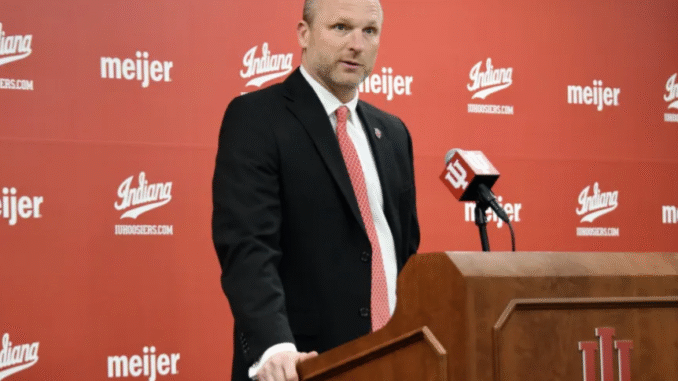
For the past eight years, Indiana basketball has been defined by its traditional big men—players like Trayce Jackson-Davis, Joey Brunk, Race Thompson, Kel’el Ware, Oumar Ballo, and Malik Reneau. These back-to-the-basket, paint-dominating, shot-blocking frontcourt players have been central to the Hoosiers’ identity under their two most recent head coaches.
Enter Darian DeVries, the new head coach in Bloomington, who is steering the program in a modern direction. The era of rosters built around 7-foot, slow-footed centers appears to be over. The post-heavy, inside-out offense that Hoosier fans have both loved and grown frustrated with is fading into the past. DeVries’ offseason moves make this clear.
Of the 11 newcomers to the Hoosiers this spring, only Davidson transfer Reed Bailey stands at 6-foot-10 or taller. Transfers Josh Harris and Sam Alexis, both 6-foot-8, are the next tallest. Nearly 75 percent of the roster is 6-foot-7 or shorter, with most projected as guards or wings. This shift raises a critical question for the 2025-26 season: Can Indiana’s smaller lineup compete in the rugged Big Ten?
This question was posed to DeVries at IU’s annual fundraising event on Wednesday. While it’s too early to know definitively—offseason practices haven’t even started—DeVries offered more than a vague response. His answer blended realism with optimism.
DeVries acknowledged the roster’s lack of traditional size. “I don’t anticipate us having great rim protection,” he admitted. “We’re a little undersized at the five spot.” For a moment, this candor might have rattled Hoosier fans. If the head coach sees a frontcourt disadvantage, why should fans feel confident?
But DeVries quickly pivoted to a hopeful vision. “Rim protection isn’t just about blocking shots—there are many ways to achieve it,” he said. “On paper, I like the balance we have. We can lean into a variety of strengths.”
DeVries’ West Virginia team last season serves as a blueprint. Only one player, Eduardo Andre, was 6-foot-11 or taller, and he was a situational reserve. The Mountaineers’ top rebounder, Amani Hansberry, was a 6-foot-8, 240-pound non-traditional center, yet DeVries entrusted him to anchor the paint. Despite lacking a true shot-blocker, West Virginia finished with the No. 15 defense nationally per KenPom, boasting a 93.9 defensive rating—better than top-six NCAA Tournament seeds like Clemson, Oregon, Ole Miss, and Wisconsin. The Mountaineers narrowly missed the NCAA field.
If DeVries could craft a top-20 defense without a dominant big man at West Virginia, there’s reason to believe he can do it at Indiana. “I feel really good about the five position,” he said. “Our guys fit how we want to play. Offensively, they can handle the ball, facilitate, and make plays. We have good depth there.”
Indiana’s frontcourt trio of Bailey, Alexis, and Harris will face immediate challenges. The Big Ten is unforgiving, with a steady influx of 7-footers each season. To compete, Indiana’s defense must rely on connectivity and cohesion across all positions. Without a traditional rim-protector, the Hoosiers will need relentless on-ball pressure, active switching, aggressive pursuit of passing lanes, and creative lineups.
The question of Indiana’s rim protection remains unanswered as practices loom, but DeVries is brimming with ideas. Hoosier Nation will need an open mind to embrace this departure from the program’s recent past. “There will be nights when we’re undersized defensively,” DeVries admitted, “but size isn’t everything. You can offset it in many ways. The right mindset is key, and I believe our guys will bring it.”

Leave a Reply